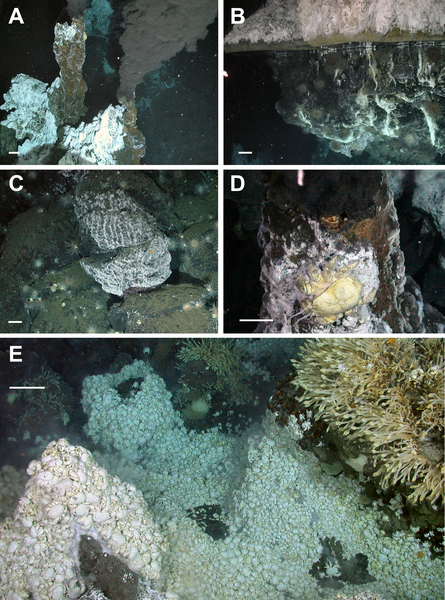It also has communities of species previously unknown to science on the seafloor.
This hot, dark environment surrounding hydrothermal vents was explored using a Remotely Operated Vehicle (ROV) and the researchers found new species of yeti crab, starfish, barnacles, sea anemones, and potentially an octopus.
The images show huge colonies of the new species of yeti crab, thought to dominate the Antarctic vent ecosystem, clustered around vent chimneys. Elsewhere the ROV spotted numbers of an undescribed predatory sea-star with seven arms crawling across fields of stalked barnacles. It also found an unidentified pale octopus, nearly 2,400 metres down, on the seafloor.

(A) Active black smoker chimneys at E2 (Dive 128, 2,602 m depth). (B) Vent flange at E2 with trapped high-temperature reflective hydrothermal fluid (Dive 129, 2,621 m depth). (C) Microbial mat covering rock surfaces on vent periphery at E2 (Dive 134, 2,604 m depth). (D) Active vent chimney at E9 supporting the new species of the anomuran crab Kiwa. (Dive 144, 2,396 m depth). (E) Dense mass of the anomuran crab Kiwa n. sp. at E9 with the stalked barnacle cf. Vulcanolepas attached to nearby chimney (Dive 138, 2,397 m depth). Scale bars: 10 cm for foreground. See citation for credit.
"What we didn't find is almost as surprising as what we did," said Professor Alex Rogers of Oxford University's Department of Zoology, who led the research. "Many animals such as tubeworms, vent mussels, vent crabs, and vent shrimps, found in hydrothermal vents in the Pacific, Atlantic, and Indian Oceans, simply weren't there."
The team believe that the differences between the groups of animals found around the Antarctic vents and those found around vents elsewhere suggest that the Southern Ocean may act as a barrier to some vent animals. The unique species of the East Scotia Ridge also suggest that, globally, vent ecosystems may be much more diverse, and their interactions more complex, than previously thought.
In April 2011 Professor Rogers was part of an international panel of marine scientists who gathered at Somerville College, Oxford to consider the latest research on the world's oceans. A preliminary report from the panel in June warned that the world's oceans are at risk of entering a phase of extinction of marine species unprecedented in human history.
"These findings are yet more evidence of the precious diversity to be found throughout the world's oceans," said Professor Rogers. "Everywhere we look, whether it is in the sunlit coral reefs of tropical waters or these Antarctic vents shrouded in eternal darkness, we find unique ecosystems that we need to understand and protect."
Citation: Rogers AD, Tyler PA, Connelly DP, Copley JT, James R, et al. (2012) The Discovery of New Deep-Sea Hydrothermal Vent Communities in the Southern Ocean and Implications for Biogeography. PLoS Biol 10(1): e1001234.
doi:10.1371/journal.pbio.1001234





Comments